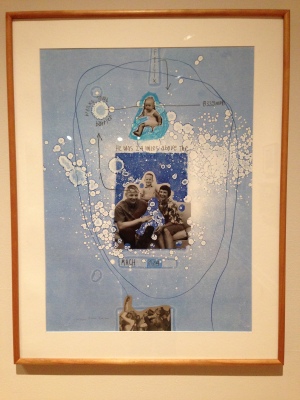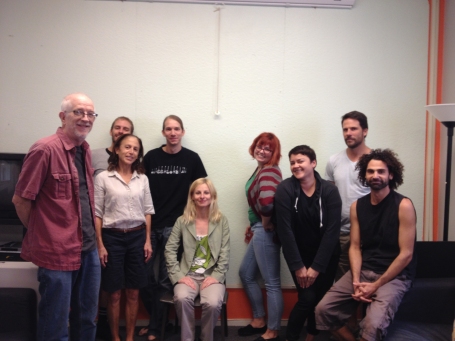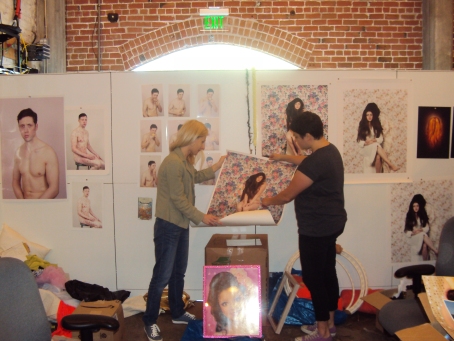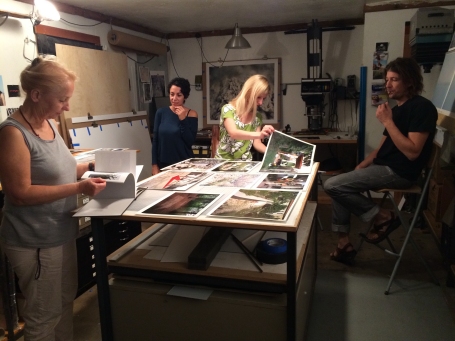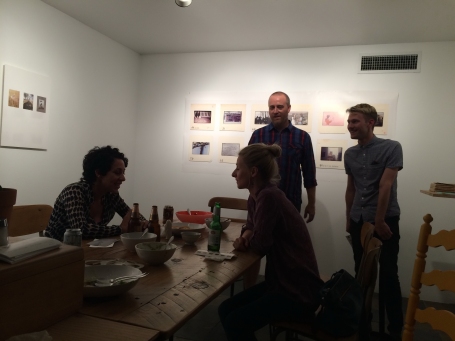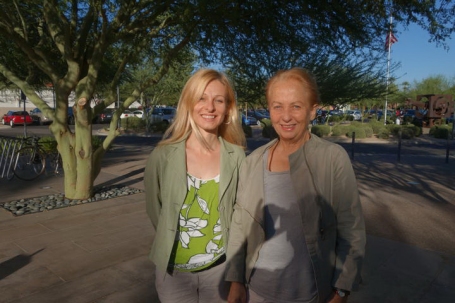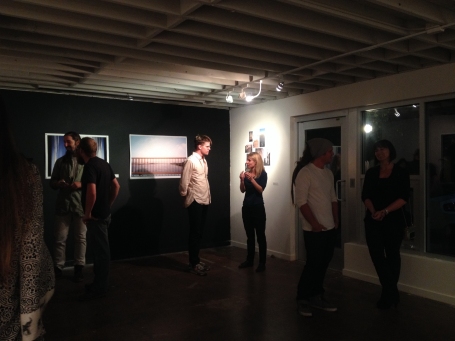Big Al is Definitely ‘Larger than Life’
“I don’t really have a style. I just do it. I love lines, I feel lines. I see something, I say, ‘Man, that’s nice!’” – Allen B. Carter
This month the ASU Art Museum is presenting the work of the talented but humble Allen “Big Al” Carter, and looking at the legacy he left behind, I admire many characteristics of his work.
Sketched and painted with thin to thickened lines, he expresses a variety of emotions through his artwork, as well as through his dominate color choice of green and blue tones. In the exhibition of work currently on view at the ASU Art Museum, titled Big Al: Larger than Life (now through Aug. 22, 2015), each painting depicts African American life as Big Al saw it —from portraits of both the rich and the poor to art made on wooden chairs, lamp shades, and even on a wooden room divider —reflecting his compulsive habit to make art on and with almost anything. Comparing one artwork to another, Carter has a style that is distinct and I am able to notice the difference in emotion, energy, and scene which I feel is what makes his art “larger than life.” He is a painter that paints from the heart, for the world, for freedom of his expression, and seeks to illustrate how he views individuals in society, including many people in his own life that he’s known.

Allen B. Carter, “Carp.” Mixed media, 29 x 50 in. (Image courtesy Vanderbilt University / Steve Green)
In this exhibition, one work titled Carp showcases his unique technique and style. Viewing this piece, I found that it was different from the rest because of the combination of two separate artworks combined as one. It’s one of several works that depicts an individual fishing. Through my research about Carter, I found that his art often recaps some of his life experiences; his love for fishing is incorporated in many of his artworks. He also utilizes different types of unconventional materials — including using Popsicle sticks that adhere to the canvas and are painted over to add a unique texture.
The texture he creates in these depictions of fisherman at sea draws you in the painting. In the top portion of the painting, he uses the Popsicle sticks in place of the sky, and then transitions into creating a more monochromatic and sketch-like picture. Most of his work seems to leave the viewer open to their own ideas. Through his sort of playful approach you can tell he had compulsive desire to make art with anything he could get his hands on. Even though Big Al was a classically trained artist, he did like to refer to himself as an “outsider” artist. He focused on making his art speak for itself, which I think he achieved.
On another piece, a painted wooden room divider titled Intense, his usage of color depicts different types of emotions. The color selection perfectly describes the title of this painting. This piece is only painted on one side, perhaps so that all viewers stand in front of it together. I had the opportunity to take a group of second grade students on a tour of this exhibition, and as we gathered in front of this piece, I asked them what emotions are associated with the colors in the painting. In response, the kids were able to distinguish the shades of blues and greens associated with the feelings of sadness and despair. They were energetic and very eager to get close to the art, and I know that this colorful exhibition heightened their excitement.
As a viewer, looking at Big Al’s artwork, you are encompassed by his life, the people in it, and his passion to create art on objects you would have never think to paint on. I hope that everyone will make a visit to the ASU Art Museum and leave with an idea of who Big Al was, his personality, and the artistic products of his unique way of living.
— Leilani Solema, Public Relations and Marketing Intern
Big Al: Larger Than Life is on view in the Kresge Gallery at the ASU Art Museum through Aug. 22, 2015. All works in this exhibition are on loan from Flora Stone and Cecilia Carter. This exhibition is supported by the Herberger Institute for Design and the Arts and the Evelyn Smith Exhibition Fund. Big Al: Larger than Life was curated by Dana and Steven Tepper and was designed by Stephen Johnson, chief preparator.
Sneakers and Capri Sun at the ASU Art Museum
You don’t normally find a large illustration of sneakers and Capri Sun when you walk into an art gallery, but Brooklyn-based artist Katherine Bernhardt’s style and bold choice of colors was hard to look past. After I discovered her painting titled “Sneakers, Computers, Capri Sun,” included in the Unfixed: New Painting exhibition in ASU Art Museum’s Top Gallery, I did some research and found that Katherine Bernhardt was not only an artist, but someone who is obsessed with fashion as much as I am.

Katherine Bernhardt, “Sneakers, computers, Capri Sun,” 2014. Acrylic and spray paint on canvas, 96 x 120 in. Image courtesy of the artist.
A recent exhibition of Bernhardt’s work at the Canada Gallery in New York titled “Stupid, Crazy, Funny, Ridiculous, Patterns” showcases similar bold and random artworks. With acrylic and spray paint, Bernhardt is able to turn coffee and cigarettes, hamburgers and French fries, and cassettes tapes into masterpieces.
Bernhardt uses a similar technique in the piece on view at the ASU Art Museum. I am especially drawn to the large-scale Nike sneakers illustrated on the canvas. Perhaps this is a reference to style statements of the ‘90s or a youthful expression of her obsession with sneakers — but I loved it, from the color scheme to her unmodified brush style. Other objects including Apple desktop computers and silver pouches of Capri Sun, outlined in silver spray-paint, are both a representation of time and life. If you grew up in the ‘90s, this may give you a feeling of nostalgia to the days when you actually brought your lunch to school or did not have the luxury of taking your laptop to class. Large brush strokes of yellow paint that fill the background, making these objects a strong focal point.
I admire Bernhardt’s sense of humor in her artwork and the way she incorporates fashion and pop culture. She combines subjects you would never think go together to create cool patterns. She’s also known for her fascination with models, something that is seen in her earlier works. Brands such as Chanel have even included her work in their stores.
Personally, I am drawn to artists who use art to share their voice in fashion — and I feel though fashion is overlooked as art form. I have a deep appreciation for their ability to illustrate their own sense of style and ideas on canvas other than constructing or photographing the latest designer fabrics or collections. Viewing Bernhardt’s piece, I was reminded of fashion illustrator Donald Robertson, who conveys a similar style. He takes objects such as lips, models, or even pink flamingos and draws them in repeated patterns, similar to the way Andy Warhol would have done in the 1960s. Robertson, like Bernhardt, has collaborated with companies and designers, including Kara Ross and J.Crew for major fashion campaigns.
I love that these artists are able to make a handbag or outfit ten times more interesting and unique! They are able to create some of the most original patterns and textiles but with paint. Whether you are into fashion or not, I think anyone can appreciate the ways that artists such as Katherine Bernhardt can produce such a variety of work.
— Leilani Solema, Public Relations and Marketing Intern
Unfixed: New Painting is on view through June 6, 2015 in the Top Gallery at the ASU Art Museum. This exhibition was made possible by generous loans and support of the Ovitz Family Collection, Los Angeles. Additional support from the Helme Prinzen Endowment.
Introspective Elements — Tan Ping’s ‘Follow My Line’
Walking into the Kresge gallery at the ASU Art Museum, the visitor is confronted with several charcoal drawings installed on pedestals at various heights. The pedestals are placed sporadically throughout the floor and lack a sense of guidance, venturing from the conventional means of displaying artwork. Toward the back of the room, we can enter a space created to show a documentary of Chinese artist Tan Ping’s process in making the drawings as well as an interview with the artist. The screech of the charcoal against the paper may be a bit much, but it is here that you can begin to understand the artist’s intention in the odd but interesting display of his exhibition, Tan Ping: Follow My Line.
Many art galleries and museums have a structured way of exhibiting their pieces. The artwork is framed, hung on a wall and placed in a specific spot that coincides with the visitor’s path through the space. If a piece is placed on a pedestal, there is a certain amount of distance created between the object and viewer using a covering or extra space around the piece. Tan Ping breaks this standard by displaying his work on a flat and uncovered surface. This sort of decision is not only to break the typical methods of exhibition; it also relates to traditional Chinese art presentation and engages the viewer in a much more dynamic way.
Chinese scrolls are laid down flat and unrolled to reveal the artwork within. Although Tan Ping’s charcoal drawings are far from scrolls, they do connect with this aspect of Chinese art by being viewed from above and from the same position that the artist had during its creation. Another traditional aspect of Tan Ping’s charcoal drawings comes in the way that we can see the variation of pressure and direction of each line. These traits are important in the production of Chinese art and calligraphy.
“The end of an exhibition is to communicate with the audience.” Tan Ping’s display helps viewers to not only view his drawings from various angles, but also from the same perspective that it was created. The pedestals in the room are specifically measured to match the height at which they were created. This helps to adjust the visitor to the artist’s viewpoint in order to analyze and understand each piece. While looking at paintings or drawings hung on a wall may be a standard, Tan Ping’s horizontal display invites the viewer to cross the distance created between the art and the viewer. The pedestals used in the exhibition are uncovered and measured to fit the sizes of the drawings perfectly, leaving nothing to distance the viewer from the drawings.
With these stimulating and introspective elements put into the ideas of this exhibition, trying to subscribe them to standard museum and gallery set-ups might take away a significant amount of meaning attributed to the show. Tan Ping had a substantial amount of input into exactly how the show was set up. He indicated measurements of each pedestal down to the millimeters length of each drawing, decided the exact colors of the pedestals, and planned out the arrangement of the pieces. His involvement in the layout of the exhibition was extensive and left almost no detail unexplained. The preparator did have some freedom in deciding how to adjust the lighting and nudging the pedestals to comply with ADA standards, but little aside from these minor details.
Apart from the layout of the exhibition, the pieces are quite abstract. Each drawing is different but without titles or any particular switch or change in medium or color, the drawings can blend together. Overall, I wasn’t able to focus on the drawings themselves but more on how the exhibition invited the viewer to see things from the artist’s perspective. The two documentaries were my favorite parts of the exhibition because they explain the artist’s intention. After watching one, it becomes more apparent what you are really looking at and why.
In many exhibitions, visitors arrive ready to gaze at paintings and drawings and learn about art. Follow My Line adjusts the visitor’s experience to engage the artwork that they view with his precision in presentation and depth in meaning. I think that this exhibition surprised me with its arrangement, but who wants to walk into an art gallery and see something that they would expect?
— Hannah Weston, Public Relations and Marketing Intern
Tan Ping: Follow My Line is on view through May 16, 2015 in the Kresge Gallery at the ASU Art Museum. This exhibition is generously supported by Tan Ping Studio, the Helme Prinzen Endowment and Pifo New Art Gallery.
All photos by Hannah Weston.
From Belgrade to Tempe: Maida Gruden
Editor’s note: Earlier this year, the ASU Art Museum International Artist Residency Program hosted Maida Gruden — art historian, curator and CEC ArtsLink Fellow for 2014. Here’s a firsthand look at her time with us in Arizona:
As a visiting curator at the ASU Art Museum International Artist Residency Program at Combine Studios, I was provided firsthand knowledge of a residency program with an excellent organization and productive working calendar.
On October 9, the same day I arrived in Phoenix, my lovely hosts Estrella Payton and Greg Esser took me to a welcome reception (at Peter Held’s home) for Garth Johnson, incoming curator of ceramics for the ASU Art Museum Ceramics Research Center. I met Gordon Knox, director of the ASU Art Museum and a number of people working for the museum, as well as students who were invited to the reception. I had a wonderful evening making a good start in connecting with people of the Phoenix art community.
The next day Greg took me to the official grand opening of the new Changing Hands Bookstore at The Newton. This incredible bookstore with a bar and a restaurant was officially opened by Phoenix Mayor Greg Stanton. I met the mayor of Phoenix and it was just the second day of my residency!
Getting acquainted with the neighborhood of the Roosevelt Row Arts District, in the urban core of downtown Phoenix, demonstrated how art can play an important role in society and community. I was fascinated with how Roosevelt Row fostered an urban renewal and is still doing it. It was such a pleasure to live in this neighborhood during the residency.
From Roosevelt Row, I was going to Tempe on a daily basis to meet students and their professors in the ASU Herberger Institute for Design and the Arts School of Art. Since my focus of research is in photography, I met with graduate photography students in their seminar class with professor William (Bill) Jenkins. They wanted to know more about the artist-in-residence program for young photographers that I am developing at the Student’s City Cultural Center in Belgrade. We arranged the schedule for me to visit each of them in their studios.
During the next week, I visited the ASU School of Art Grant Street Studios in downtown Phoenix and I viewed the work of graduate students including Clarita Lulić, Ryan Parra, Thomas Locke Hobbs, Samantha Lyn Aasen, Buzzy Sullivan, Ashley Czajkowski, Monica Garcia, Taylor James and Pam Golden. I was delighted by the diversity of their work as well as their capacity to develop their own specific photographic language. I am glad I had a chance to visit their group exhibition at ASU School of Art Night Gallery at Tempe Marketplace, an experimental space that explores the newly conceived role a university can play outside of its expected domain.
I had a brief opportunity to attend the installation of the exhibition FAMILY MATTERS, revisited together with undergraduate students in photography and Professor Liz Allen, director of the Northlight Gallery on ASU’s Tempe campus. The exhibition opened on October 21 and on that occasion I had a chance to meet exhibiting artists Marivi Ortiz and H. Jennings Sheffield, as well as ASU professors in photography Mark Klett and Stephen Marc Smith.
My further research of student’s work and curriculum expanded into intermedia. It was a pleasure to host Professor Gregory Sale and his students in Intermedia (Herberger Institute for Design and the Arts) in the common room at Combine Studios. We shared our experiences discussing community-based projects in Arizona and Serbia. The atmosphere was informal but a very inspiring one, and we had a wonderful time talking to each other. I learned a lot from each of them. The meeting was organized with the support from Greg and Estrella, who were also participating in the conversation. I visited Gregory Sale’s class again the following week in the Tower Building on ASU’s Tempe campus continuing the fruitful exchange of our opinions and ideas.
On October 28, I gave a public lecture at the ASU Art Museum in Tempe. I talked about projects I’m developing at Students’ City Cultural Center in Belgrade as well as the activities of maramaida curatorial duo. It was also a good opportunity to discuss differences and similarities between ASU’s campuses and Students’ City during the conversation that was opened after the talk and to share ideas about students’ exchange programs. The audience was interested to find out more about my host, the CEC ArtsLink program and the additional opportunities that they provide.
The same evening, after my public talk I visited the ABBA (A Bunch of Book Artists) show at the Harry Wood Gallery. My involvement in the Extended Field of Book project in Belgrade gave me a lot of ideas how these two collectives from Belgrade and Tempe could be connected. I am glad I met Professor Dan Meyer and graduate student Monica Garcia, both of whom are involved in ABBA.
Thanks to my hosts, I was introduced to a number of emerging and accomplished artists. I visited studios and had inspiring conversations with Arizona photographers including Sean Deckert, William LeGoullon, Edgar Cardenas, Claire A. Warden, David Emitt Adams, Nidaa Aboulhosn, Michael Lundgren and Dana Buhl.
I visited Carol Panaro-Smith and James Hajicek’s Alchemy Studio where they both work and teach different photographic processes diving deep into the history of photography. They showed me new inspiring contemporary approaches to old photographic techniques.
I also had the great experience of attending The Table initiated by Dana Buhl, photographic artist and curatorial coordinator at Scottsdale Museum of Contemporary Art. Wanting to fill the gap, that according to her opinion, was present in the Phoenix art scene, she opened a new space at her house for photographic exhibitions and for people to come, have a dinner and conversation about art. The focus of The Table that I attended was an exhibition Guided Conversation by Mike Williams. The evening-long dialogue was very interesting and inspired with participants including Gordon Knox, Bill Jenkins, Claire Carter, Greg Esser, Dana Buhl, Michael Lundgren, Nidaa Aboulhosn, Max McLeod, Erick Lundgren and Charles Anthony Darr.
Part of the beauty of international artist residency programs is that you can meet people you admire and spend an inspiring time with them. During my residency in Phoenix I met renowned Slovenian artist and architect Marjetica Potrč, who made a brief visit to Phoenix in order to plan a return visit the following year with her students to conduct a project in partnership with the ASU Art Museum International Artist Residency Program.
The ASU Art Museum’s Senior Curator and Associate Director Heather Sealy Lineberry and Print Curator Jean Makin gave me a wonderful tour around the museum’s various collections. I was fascinated with the possibilities that the ASU Art Museum provides for students and their research.
Thanks to the ASU Art Museum, I had a chance to take a one-day trip to Tucson. It was great meeting Rebecca Senf, curator at the Center for Creative Photography, who gave Greg and me a guided tour around the center. Visiting the Photography Conservation Lab and listening to Dr. Jennifer Jae Gutierrez, senior Photograph Conservator, about conservation processes and the up-to-date equipment that the center possesses was a special experience.
An excellent exhibition, Performance: Contemporary Photography from the Douglas Nielsen Collection was on display at the Center featuring works of Diane Arbus, John Baldessari, Jo Ann Callis, Nan Goldin, Bruce Nauman, Richard Renaldi and Cindy Sherman, among others. I was happy to be in Tuscon to see it.
Our next stop in Tucson was Etherton Gallery, where I had the pleasure to meet Terry Etherton, founder of the gallery. On view was an exhibition titled Land Exposures (with works by Jamey Stillings, Richard Laugharn, David Emitt Adams and Chris Colville). We stayed for the panel discussion “The Evolution of Ivanpah Solar.” Jamey Stillings’ photo project provided the basis for a panel discussion and community questions exploring various challenges, impacts and benefits presented by large renewable energy projects and how we balance those to achieve the most desirable outcomes.
In Tucson I also met Josh Schachter, photographer, multimedia educator and community artist who shared more information about his numerous projects with students, refuges and variety of organizations and institutions.
During my five-week residency stay I had the opportunity to meet a number of local artists and ASU students to view and learn about their work and processes. This short but eventful time brought me the opportunity to develop an exhibition at the Combine Studios gallery based on my interactions with photographers from Phoenix and recent collaborations with photographers from Belgrade. The opening reception of the exhibition Convergence / PHX – BG was on First Friday, November 7, 2014.
Convergence / PHX – BG is an exhibition of photographic works by the following artists from Phoenix and Belgrade: Ryan Parra, Claire A. Warden, Nidaa Aboulhosn, Edgar Cardenas, Sean Deckert, William LeGoullon, Goran Micevski, Ivan Petrović, Stefana Savić, Nina Todorović, Aleksandrija Ajduković and Mihailo Vasiljević. The exhibition represents a generational cross-section of artists from their twenties to their forties. It indicates a first step in connecting the artists, audiences, photographic processes and people from two distant towns. The title Convergence / PHX – BG is intended for the viewer to consider similarities but also to raise interests for differences that enrich and intrigue our local perspectives. The same exhibition will be presented at the Students’ City Cultural Center Gallery in Belgrade at the beginning of 2015.
The effects of this convergence will be to create a space for personal encounter and dialogue between artists from Phoenix and Belgrade, and to help develop collaborative and exchange projects in the future. It was my pleasure to find out that many of the photographers from Phoenix met each other in person for the first time through their participation this exhibition that I curated.
The grand finale of my residency was a one-day trip to Grand Canyon with Greg and Felipe Goes, a painter from Sao Paolo. We had a wonderful time, hiking and enjoying fascinating views of the Grand Canyon until the sun set. We enjoyed beautiful changing colors, moving shadows, perfect air and a time trail comparing geologic time to footsteps along the rim.
This residency program was enormously important in expanding my professional network and opened a number of options for potential collaborative projects that could be developed in the future. In addition to CEC ArtsLink who funded my residency, I would like to thank the ASU Art Museum and my hosts there, Greg and Estrella, for their organization, support, energy, love and commitment!!!
See you again.
— Maida Gruden
Gruden’s residency was funded in part through the support of ArtsLink Residencies which offers artists and arts managers from 37 overseas countries five-week residencies at non-profit arts organizations throughout the US. The program enables artists and communities across the U.S. to share artistic practices with artists and arts managers from abroad and engage in dialogue that advances understanding across cultures.
December 29, 2014 at 11:07 pm ASU Art Museum Leave a comment
Ask our curators your questions tomorrow! #AskACurator day is Sept. 17, 2014
Join the international conversation on Ask A Curator Day 2014, this Wednesday! The ASU Art Museum’s Heather Sealy Lineberry and Andrea Feller will be answering your questions all day on Twitter @ASUArtMuseum. Follow live with hashtag #AskACurator.
We’re proud one of over 600 museums participating in this social media event this year! To send us your questions, tweet with the hashtag #AskACurator and tag @ASUArtMuseum and we’ll answer. You can direct your questions to either Heather (HSL) or Andrea (AF), or to both! You can even tweet your questions today and we’ll save them up to answer on Wednesday.
To learn more about #AskACurator day and see a full list of participating museums, visit: http://www.mardixon.com/wordpress/askacurator-who-to-ask/
September 16, 2014 at 8:52 pm ASU Art Museum Leave a comment
Dispatches from Madrid: On the Road with Charles Demuth
Editor’s note: Last month, the ASU Art Museum’s Teresa Shannon, assistant registrar (and recent ASU graduate!) headed to Madrid to oversee the safe travel of a Charles Demuth painting from the museum’s collection, entitled A Sky After El Greco. Here’s a firsthand look at her trip:
The Madrid airport, unlike our own Sky Harbor, only has one exit from the international arrivals terminal. While this made for a hectic and crowded journey through customs, at the end it rewarded me with one of the happiest experiences of travel: seeing family awaiting the arrival of a loved one. Gobs of children and adults press themselves against the security barrier and burst into cheers when they glimpse the face of their family member in the crowd of us moving toward the exit. In the midst of all the smiling faces stands a man in a business suit holding a piece of paper with my name spelled out in all caps. I rush over to introduce myself to the man who will escort me from the airport to the Museo Nacional del Prado.
My escort’s name is Guillermo and he works for SIT Spain, a company that specializes in the packing and transportation of art, as well as museum and exhibition conservation and design. Guillermo is here to help me complete my duties as an art courier. This journey started two days before in Arizona, when I began escorting the ASU Art Museum’s Charles Demuth painting: A Sky After El Greco, first to Los Angeles and then to Madrid, for the El Greco and Modern Painting exhibition (on view June 24 – Oct. 5, 2014) at the Museo Nacional del Prado.
This second half of my journey is where the real work would start. Antonio drives to the freight packing area of the airport and I watch as the crate containing the painting is loaded on to a truck and strapped securely in for its drive to the Prado. Following this truck to the museum gives me my first glimpse of beautiful Madrid, where cars darted down tree-lined, one-way streets and people walk briskly on a mixture of well-maintained sidewalks and treacherous cobblestone paths.
We arrived at the museum’s loading dock, and only after showing my passport am I allowed into the building. The crate is taken from the truck and delivered directly into the exhibition space where it will be shown. Many pieces of artwork are already hanging in the gallery and I am able to walk though and view them as I wait. It is a humbling and exceptional experience to get a behind-the-scenes view of how an exhibition of this size is put together. The crate stays overnight in the museum to acclimate to the new environment and I am taken to my hotel.
The night life in Madrid is incredible. Although it is around 7 p.m. when I finally make it to my hotel for check-in, the city is still bright with sunlight and the people are just making their way out for pre-dinner drinks. Never one to buck local customs, I head out for a night of exploring with a fellow courier from San Francisco and a conservator from the Metropolitan Museum in New York. We stroll through quaint alleys to a sherry bar called La Venencia, which was once a favorite haunt of bullfighting-obsessed writer Ernest Hemingway. In the narrow bar we sip a glass of dry white wine and snack on fresh green olives.
Our little group then makes its way to a plaza filled with people just beginning dinner. Madridians are late dinners — I mean late! Most restaurants do not even begin serving dinner until 9 p.m., and then don’t close their kitchens until 1 a.m. The old and the young congregate in the town squares or plazas that dot the city. Street performers, trinket sellers, palm readers and children come together to create a carnival-like atmosphere, not just on weekends but every night. It’s easy to get wrapped up in the fun and before we knew it midnight had come. Though the streets are still full of merry people, we decide to call it a night.
The next day I make my way on foot to the Prado for the unpacking and hanging of the Demuth. I pass lovely buildings and luscious green parks while the sound of people speaking Spanish surrounds me. Before I can feel completely out of my element, I spy a very large Starbucks, and shaking my head at the sight, I cross the street to enter the Prado. The staff at the museum welcomes me and again takes me behind closed doors into the exhibition space. For two hours I stand with other couriers from around the world as the museum’s staff unpack, examine and hang paintings by or inspired by El Greco. The efficiency of this group is amazing and they work quickly yet safely to display the artwork. After an intense examination of A Sky After El Greco is performed by the Prado’s lead paper conservator, the Demuth is hung in a side gallery space dedicated to artists from the Americas. This space, called Area 7 in the exhibition checklist, also features Jackson Pollock and Thomas Hart Benton.
After the painting is hung, the staff quickly moves on to the next painting and I exit the exhibition area to explore the Prado. Their collection is astounding. Walking from room to room, I see masters such as Caravaggio, Hieronymous Bosch, Peter Paul Rubens, Francisco Goya and Diego Velázquez. Never before have I been so completely in love with art as the moment when I walked around a corner and saw the Prado’s Mona Lisa, attributed to a student of Leonardo da Vinci, who most likely painted alongside him and copied his every brush stroke (learn more in a New York Times article on this painting!) With the audio guide to my ear, I learn that this stunning painting is a close copy of Leonardo’s original, which has hung in the Louvre since 1797, but the background behind the figure is more complete.
With my duties as a courier complete, I am now free to explore the city for the next two days. I feel incredibly fortunate to visit this cosmopolitan place, and will use my free time to see the Royal Place, the National Cathedral, the Bibliotheca and the archeological museum — and of course, eat lots of tapas! Madrid is a fantastic place, not only for the vast array of museums and attractions it offers, but also the history, the culture and the obvious pride the people take in their city.
To see more from Teresa’s visit to Madrid and the life of a registrar, search #trs1986travels on Instagram.
Saturday, July 12 – Family Fun Day at the ASU Art Museum
‘Comically’ fun educational activities for children of all ages!
At this year’s event, enjoy face painting, interactive music, dance and magic performances from Persephone, C3 Dance and Jolly Roger. Get creative while making cartoon critters, superhero capes and shields, paper hats, pendants and more!
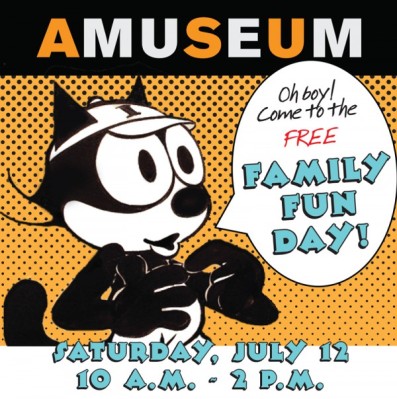
Hearkening back to Sundays of childhoods past, when there was a mad dash for the comic pages, Funny Papers (on view now through Sept. 6, 2014) explores the history of comic strips and their continued prevalence throughout art. The whole family is sure to enjoy the collection of both vintage comic strips and contemporary art infused with comic icons. You’ll leave laughing out loud — and wanting to draw some comics of your own. This exhibition is curated by Jean Makin and supported by the Evelyn Smith Exhibition Fund.
New Sergei Isupov work added to the collection
The ASU Art Museum is thrilled to add its first Sergei Isupov sculpture into the permanent ceramics collection thanks to David Charak, Ferrin Contemporary and the artist. Isupov’s piece, Firey, created from stoneware, stain and glaze, is a beautiful new addition to the collection. It was given to the museum from a series of Isupov’s large-scale heads and appeared at the NCECA 2009 conference at the Mesa Contemporary Arts.

Sergei Isupov, “Firey,” 2009. Stoneware, stain, glaze. 25 ¾ x 19 ½ x18 in. From the ASU Art Museum collection, gift of David Charak, Ferrin Contemporary and Sergei Isupov.
Russian-born artist Sergei Isupov is quite often called an erotic Surrealist for his bold depictions of sexuality, relationships and human encounters. He uses his own experiences as well as human observation to create a unique approach to the world of sculpture. “My work portrays characters placed in situations that are drawn from my imagination but based on my life experiences,” said Isupov. “My art works capture a composite of fleeting moments, hand gestures, eye movements that follow and reveal the sentiments expressed.”
Various narrative themes are conjoined together to create Isupov’s sculptural ceramic forms, inspired by particulars from his life. Personal interpretation is very much expected with his work.
Isupov states that, “Through the drawn images and sculpted forms, I capture faces, body types and use symbolic elements to compose, in the same way as you might create a collage. These ideas drift and migrate throughout my work without direct regard to specific individuals, chronology or geography…Through my work I get to report and explore human encounters, comment on the relationships between man and woman, and eventually their sexual union that leads to the final outcome — the passing on of DNA which is the ultimate collection — a combined set of genes and a new life, represented in the child.”
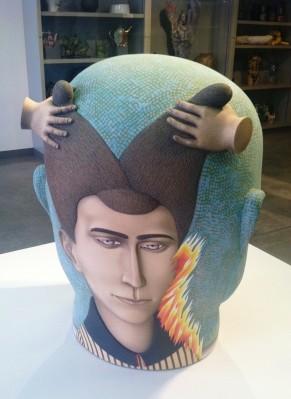
Sergei Isupov, “Firey,” 2009. Stoneware, stain, glaze. 25 ¾ x 19 ½ x18 in. From the ASU Art Museum collection, gift of David Charak, Ferrin Contemporary and Sergei Isupov.
Firey, alongside numerous other ceramic works from the ASU Art Museum’s collection, is on display now at the Ceramics Research Center at the Brickyard, located at 699 S. Mill Ave, Suite 108, Tempe, Ariz. 85281. If you haven’t seen our beautiful new space yet, you’re missing out! Plan your visit today, or call 480.727.8170 for directions and hours.
— by Nicole Lechner, ASU Art Museum intern
Artist Pablo Helguera talks language insiders, e-books and ‘Librería Donceles’
This spring, the ASU Art Museum presented two concurrent solo exhibitions of work by artist Pablo Helguera. Pablo Helguera: Librería Donceles and Pablo Helguera: Chrestomathy, are the first presentations outside of the East Coast of this new work by Helguera, a world-renowned visual and performance artist whose work weaves together personal and historical narratives in the context of socially engaged art and language.
Librería Donceles is an itinerant, functional Spanish-language bookstore of 12,000 used books in Spanish on every subject—including literature, poetry, art, history, biology, medicine, anthropology and politics, as well as children’s books. To create the installation, Helguera assembled donations of books from individuals and groups in Mexico City and elsewhere, offering prints of his previous artworks in exchange for boxes of books. Librería Donceles is currently on view through June 28, 2014 in downtown Phoenix at Combine Studios Gallery, home of the ASU Art Museum International Artist Residency Program.
During one of Helguera’s recent visits to Phoenix, he sat down with Julio César Morales, ASU Art Museum Curator, and Brittany Corrales, Windgate Curatorial Assistant and master’s candidate in art history, to talk about socially engaged practice, e-books, and the “Bob Dylan of Mexico.”
JCM: Librería Donceles is a project that was born in New York City in 2013 and influenced by the fact that there are 2 million Spanish-speaking people in New York and not one Spanish-language bookstore. Here in Arizona, where English is the official language and it is against the law to teach ethnic studies in K-12 public schools, how do you see the bookstore functioning in regards to the current social environment in Phoenix?
PH: It was very important to me to be able to bring Librería Donceles to Phoenix as I see it as a way to promote knowledge of the culture around Spanish language — something that I believe is necessary if there is going to be a discussion on banning books. The project seeks to show that every language has a great depth and richness that reaches all disciplines and goes back centuries. I wanted to show that regardless of what language they are written in, knowledge is universal and contributes to the betterment of individuals and communities all over the world. I also believe that prejudice emerges from distance — it is common to judge something without seeing it with your own eyes. So we have thousands of books there now, for people to meet in person, and whether one speaks Spanish or not, I think it may be surprising for someone to walk in there and ponder on the value and importance of the book.
BC: To create Librería Donceles, you assembled donations of books from individuals and groups in Mexico City and elsewhere, offering your artwork in exchange for books and producing an Ex Libris for each donor that acknowledges the provenance of every volume. What sort of ephemera did you discover in the pages of the donated books?
PH: There were a myriad of things in them: movie tickets, subway tickets, laundry lists, religious pamphlets, love messages, cryptic messages, photos, business cards. It was amazing what we found. I particularly liked a hotel towel receipt – ones that you would use to borrow towels in the pool in places like Acapulco. They all spoke of the personal circumstances under which the book was being read.
JCM: Can you talk about the origins of socially-engaged art practice? Some may consider it a catch-all for what cannot be defined within a specific art genre. However, as a pioneer or leader within this field, can you forecast a future of how this genre might be able to push the boundaries within the traditional notions and relationships between audiences, artists and cultural spaces?
PH: You could say that art in the public realm has always existed, even before it was a commodity or it was housed in museums. Art comes from the public, from vernacular expression, and within the modernist tradition, the effort to bring art into the public realm was sort of a political gesture- ranging from the Mexican muralists until today. The practices that started emerging over the last decade ago or so was, in my view, an attempt to connect with that political spirit of social investment by furthering what process-based art had done in the previous decades, and using elements from relational aesthetics and institutional critique but trying to move on from the museum discourse. I am afraid that socially engaged art is quickly becoming an academic discipline and we may be creating already a “genre” out of it. But I believe that is, in essence, an inevitable part of the assimilative process of every new set of practices. What I don’t think is going to go away is the desire to make art matter again in the public discourse. So my hopes is that socially engaged art today, as we understand and define it right now, will evolve into new forms of art making that operate independently from the existing market structures of art.
BC: You currently work as the Director of Adult and Academic Programs at the Museum of Modern Art in New York. How has your experience in education and programming informed your art practice, or vice versa?
PH: I have done museum education on par with my artistic practice since 1991 and as a result my experiences as educator have influenced my work as artist and vice versa. It is mainly the reason why I started making work that dealt with the social context of art—because that is what you deal with as an educator— and that is why as educator I am interested in supporting forms of learning that are placed at the center of the artistic process.
JCM: In recent years, pedagogy has played an important role within the curatorial practice in major projects such as Documenta and the Mercosul Biennale in Brazil. Is it possible that we can “learn” to understand art and life in a more “speculative” understanding between the relationship of practice and exchange?
PH: Many of us believe that all this relatively sudden interest in pedagogy by the contemporary art world is nothing other than the recognition that what many artists wanted to do with their work has to do more with education than with art appreciation. We don’t want works that are there merely to be admired: we want to make works that truly matter, that truly can be transformative. And it is education theory that shows you how transformative experiences are created, ranging from John Dewey to Jerome Bruner to Paulo Freire. The problem is that pedagogy tends to continue to be perceived as didacticism, not as experiential practice.
BC: As a bibliophile, what do you believe is the role of printed books as objects in our increasingly paper-less, virtual world?
PH: There are evident and not-so evident contrasts between the physical object of the book and the e-book. But amongst the not most evident ones, there’s the issue of personal ownership. You don’t own the e-books in your library- you mainly rent them. At a first glance this may appear to seem democratic, but it is not. A corporation owns all these books, all this content basically, and gives you access to them for a fee. This has an impact on how knowledge is produced and transmitted. You can’t give away or share your library to others, you can’t lend books. So what is being lost is the personal communication and production of knowledge and experiences that lead to knowledge through the object of the book.
JCM: I have always thought of Oscar Chavez (Mexican folk singer and cultural activist) as the “Bob Dylan of Mexico.” Can you talk about the influence of his craft within your artistic practice? (I will not mention to anyone that he is your uncle).
PH: I grew up in a family of artists- some of them were classical musicians, others, like Oscar, were involved with popular traditions. In my grandmother’s house, on Sundays, we would gather and both kinds of art coexisted — we would start dinner listening to Caruso, but after dinner —and a few drinks— my aunts and uncles would sing rancheras. As a teenager I would go with my aunts to Oscar’s concerts at the Auditorio Nacional (where he still performs every year). In the 70s and 80s, during the hard years and later decay of the PRI, it was difficult to exist as a true voice of dissent. Yet Oscar never flinched and was implacable in his scathing criticism of the government—so those concerts at the Auditorio Nacional felt like true demonstrations. I always admired Oscar’s ability for satire, his integrity and the way he managed to touch the public. These days I am thinking a lot about how important is to think of that legacy for us as artists.

Helguera and curator Julio Cesar Morales enjoy a musical moment in Librería Donceles. Image by Tim Trumble.
BC: If language creates meaning, are there certain linguistic borders that are not traversable? Can you provide an example of a particular word or phrase whose nuances you find difficult to translate from Spanish to English?
PH: There are absolutely lots of linguistic borders. The easiest to identify is localism and humor. When you learn a language (and even when you are a native speaker) the most challenging thing to understand are local and internal dialects, which may make reference to things and topics that you may not be familiar with. In 1960, a Mexican writer named Armando Jiménez published a book that became an instant classic, Picardía Mexicana, which was an incredible compilation of Mexican jokes, off-color phrases and general nastiness of the language. A book like that shows you how elaborate and intricate humor can become, and how it evolves so quickly in time and place. The Mexican humor of 1960 is totally different to the one in 1970 or 1990 or today. Some jokes survive or become transformed, but it all responds to the immediate social context. Finally, there is a big difference between understanding a joke and finding it funny. You can intellectually understand why something that is said may be considered funny by some people, but when you actually laugh without analyzing it, that means that you are an insider of that language.





